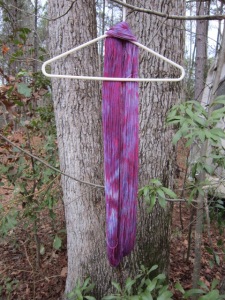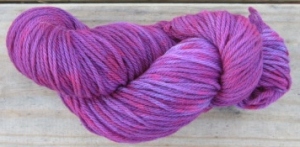I have a brilliant idea.
For those of you who know me, I CAN HEAR YOU. I hear you laughing.
For the rest of you, here we go.
Reader Sharon sent me some kettle-dyed yarns for my birthday. I’d never seen kettle-dyed yarn before, and I LOVED it. I wanted to learn more about it.
The particular yarn that she sent was “Maxima” by Manos del Uruguay, a co-op which empowers indigeneous women by giving them a world market for their kettle-dyed yarns.
I live pretty primitively here at the Swamped! Plantation and cat-catchin’ corner. Why can’t I learn how to kettle-dye yarn? Never mind that I don’t have an operating stove, much less a kettle.
I googled, then youtubed, and found several tutorials. It seems like a science experiment with yarn and food dye.
Heat is an important factor in kettle-dyeing, as is water in a kettle, and some white vinegar. And, of course, some undyed, natural yarn which I found from a supplier online.
I didn’t take pictures of the first experiment because I was afraid that it would end badly, and I didn’t want to disappoint my readers who have come to expect such a high standard of blog-worthy material. You, over there. Stop snickering.
I have a grill, and I supposed that I could make a fire in the grill, wait for the coals to settle, and heat up a container of water. That sounded dangerous somehow, so I put my unique twist on it.
I bought two of those aluminum foil-like catering-style pans. They looked big enough for a skein of yarn. I’m wondering if the people in the grocery store who saw me doing higher math on the dimensions of the aluminum foil pans had any idea of the immensity of my project.
I found McCormick food dye which I have surely not used since I was a child and we dyed Easter eggs. LilSis and I longed for those Paas Easter egg dyeing kits, and indeed sometimes we used those, and now it makes me wonder if the tablets would work on this project. On second thought, probably not.
McCormick, in addition to the standard colors, makes a neon color set. Oh, be still, my pounding heart.
I put an aluminum pan in my bathtub, because it’s cold outside, folks, and I am NOT making a fire in the grill, plus the wind had kicked up, and I could see this episode ending in a 911 call. I arranged a skein of yarn in the bottom of the pan, and I heated 4 cups of water in my Procter-Silex electric cooking pot until boiling, and poured the boiling water in the middle of the pan so as not to disturb the yarn while adding a tablespoon of vinegar for each cup. I sloshed the mix about, and swirled it gently with a plastic coffee stirrer and pressed down on the yarn with the back of a plastic spoon to get the yarn soaking wet. At the same time, I’m heating another 4 cups of water until it boils.
I added the second 4 cups of water to the pan, remembering to add another 4 tablespoons of vinegar, and that made the water deep enough to cover the yarn.
Now here’s the fun part. I took a dropper bottle of food dye, and added a drop of dye directly on to the yarn. I had no idea that it was going to take an entire bottle of dye, even though the bottles are very small, but it seemed like the best way to go since it was premeasured and gave me a standard of measurement.
I let it sit in the pan in my bathtub until it was completely cool. I might mention that I fell asleep and woke up about 10:30 PM, having forgotten about the yarn in the tub, what with old age and all that, and it was definitely cool. Add a few drops of dishwashing liquid, rinse well, and hang to dry. In my case, I hung the skein on a hanger over the pan still in the bathtub.
The yarn had completely absorbed the apple-green dye, and I’m sorry that I didn’t take photos of the before and during, only the after.
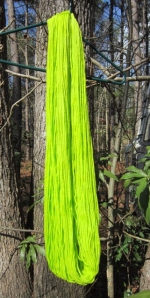
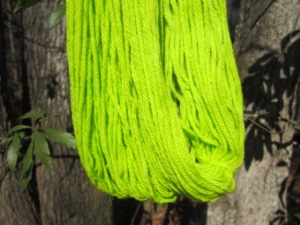
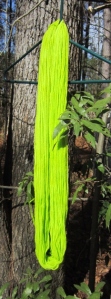
The yarn is 100% merino wool, the kind that shrinks and felts if washed in hot water and agitation, not the superwash kind.
I’m sending this skein to an internet friend in Massachusetts to work up and give me a report as to the viability of selling this product. Any thoughts?
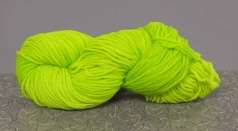
I don’t hear anyone laughing now. Save it. You’ll need it for the second episode of “Yarn Dyeing; in which there is drama”.















